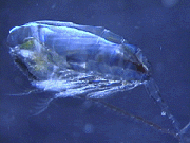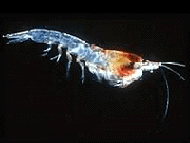|
|
The U.S. GLOBEC program currently comprises four principal study sites selected to cover a range of system types, including:
- An offshore shoal with retentive circulation (Georges Bank),
- An upwelling region (California Current off Oregon and Northern California),
- A downwelling system strongly affected by winds and freshwater inputs from land (Coastal Gulf of Alaska), and
- An ice-dominated system (the West Antarctic Peninsula region)
Each region selected exhibits characteristics that will likely be affected by global climate change. The Georges Bank region may be strongly affected by changes in temperature and precipitation that can alter the position of frontal zones or affect stratification - all of which will have important ramifications for the organisms in this system. Changes in wind fields in the California Current off Oregon and California can have dramatic impacts on upwelling, with cascading effects on the overall levels of nutrients and primary production ....
 Location of U.S. GLOBEC study sites .... |
Expected increases in rainfall at high latitudes can be expected to change the intensity of coastal currents in the near-shore Gulf of Alaska that are controlled by buoyancy-driven flows. Changes in wind fields will also affect downwelling processes in this region. Increasing temperatures at high latitudes will increase melting of polar ice in the Arctic and Antarctic. In addition to the direct effects of temperature change on marine organisms, the loss in sea ice will result in loss in a key component of habitat used by many species. This issue will play a central role in the U.S. GLOBEC studies in the Southern Ocean ....
Target species in U.S. GLOBEC studies are selected for their ecological importance, their likely sensitivity to climate change, and (for some) their economic importance. In each regional study, zooplankton species are targeted for their importance in the food web of the seas. In the case of krill in Antarctica, there also exist important fisheries for this species ....
 Calanus finmarchicus is a key zooplankton component of the food web in the North Atlantic and is one of the target species in the Georges Bank study area (Courtesy David Townsend, University of Maine). The dynamics of other calanoid copepod species are being studied by U.S. GLOBEC researchers in the Northeast Pacific .... |
 Krill have been selected as target species in U.S. GLOBEC studies in the West Antarctic Peninsula region. In the Northeast Pacific, other species of euphausiids have been targeted for study .... |
In the GLOBEC studies in the Northwest Atlantic and in the Northeast Pacific, fish species have been selected for special emphasis because of their critical importance to the commerce of these regions. In the northeast, cod and haddock have been mainstays of the commercial fisheries for centuries, but are now depleted by overharvesting. In the Pacific, salmon are important elements of local cultures, having supported native peoples for millennia and important commercial fisheries for over a century. Fish also play essential ecosystem roles as prey of many species including marine mammals, large sharks, and sea birds ....
 Larval stage of Atlantic cod. The early life stages of cod and haddock are targeted in the Georges Bank program (Courtesy Betsy Broughton, NMFS - Woods Hole Laboratory) .... |
 Coho salmon is one of the target species for the California Current component of the U.S. GLOBEC Northeast Pacific Program (Courtesy E. Keeley, University of British Columbia) .... |
 Haddock larva at 48 days (Courtesy H. Wes Pratt from larval rearing experiments at the Narragansett Laboratory, NMFS) .... |
[ Table of Contents ]
[ Top of Current Page ]
[ Advance to Next Section ]

 Study Area / Target Species
Study Area / Target Species

